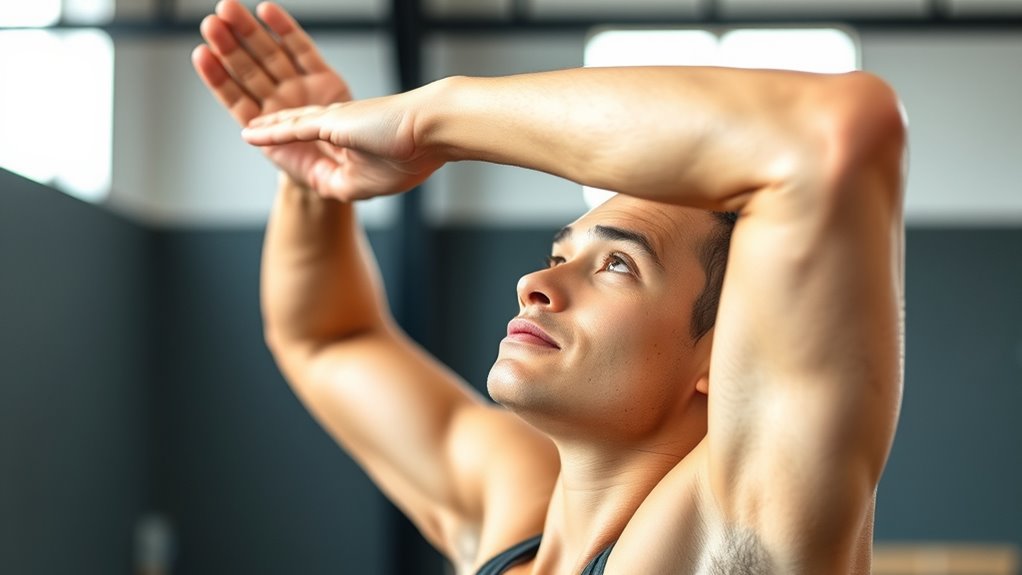Range of motion (ROM) is how far your joints can move through normal, functional movements. For athletes, having good ROM means moving efficiently, performing better, and reducing injury risks. It helps you stay flexible, maintain joint health, and prevent muscle imbalances. Improved ROM can boost strength, agility, and overall performance. If you want to understand how developing your ROM can give you an edge and keep you safe, keep exploring this topic.
Key Takeaways
- Range of Motion (ROM) is the extent of joint movement in specific directions during normal activity.
- Adequate ROM enhances athletic performance by enabling efficient, powerful, and agile movements.
- Improving ROM reduces injury risk by preventing joint stiffness and muscle compensations.
- Flexibility and mobility training help maintain or increase ROM, supporting overall joint health.
- Limited ROM can impair performance and increase strain, making it vital for athletes to optimize joint flexibility.

Have you ever wondered how athletes move with such agility and power? The secret often lies in their range of motion (ROM). Range of motion refers to the distance and direction your joints can move through normal, functional movements. When your ROM is ideal, you can perform activities more efficiently and with less risk of injury. For athletes, maintaining and improving ROM isn’t just about flexibility—it’s a critical component of injury prevention and overall performance. Without sufficient ROM, you might compensate with other muscles, increasing the chance of strains, sprains, or more serious injuries. That’s why incorporating targeted flexibility training into your routine is essential. It helps you stretch and strengthen the muscles around your joints, keeping your joints healthy and mobile.
Injury prevention starts with understanding your body’s limits. When your joints are stiff or restricted, you’re more prone to overcompensation, which can lead to imbalances and injuries. Flexibility training helps you activate tight muscles and improve joint mobility. This doesn’t mean you need to be supremely flexible like a gymnast, but rather that your joints can move freely through their full range. Regular stretching routines, dynamic warm-ups, and specific mobility exercises enhance your flexibility, making your movements smoother and safer. For athletes, this is especially significant because even a small reduction in ROM can hinder performance and increase injury risk. Think of your joints as the hinges of a well-oiled machine—if they’re stiff or rusty, the entire system suffers.
Moreover, improving your ROM can boost your athletic performance by allowing more efficient movement patterns. When your muscles and joints have the freedom to move through their full range, you generate more power and agility. This is particularly important in activities that require quick changes of direction, explosive movements, or complex skill execution. Flexibility training doesn’t just prepare your body for activity; it also helps with recovery by reducing muscle tightness and soreness. Over time, a consistent focus on increasing your ROM can lead to better posture, balance, and coordination, all of which contribute to peak athletic performance.
Frequently Asked Questions
How Can I Improve My Range of Motion Effectively?
To improve your range of motion effectively, incorporate dynamic stretching into your routine before workouts to warm up muscles and enhance flexibility. Follow up with strength training exercises that target your muscles through full ranges of motion, which helps increase flexibility and stability. Consistency is key—regularly practicing these techniques will gradually improve your mobility, reduce injury risk, and boost overall athletic performance.
What Are Common Injuries Related to Limited Range of Motion?
Limited range of motion can lead to common injuries like joint stiffness and muscle strains. When your joints don’t move freely, you’re more prone to strains from overstretching or sudden movements, and stiffness can cause joint pain. These issues often result from tight muscles or inadequate flexibility, increasing injury risk during activity. To prevent this, focus on regular stretching and mobility exercises to keep your joints and muscles healthy and flexible.
Is Stretching Alone Sufficient to Increase Range of Motion?
Stretching alone, like a lone musician playing a solo, isn’t enough to truly expand your range of motion. Static stretching can help, but for lasting gains, you need flexibility training that combines dynamic movements and strength work. This holistic approach tunes your muscles and joints, releasing better mobility and performance. So, don’t just stretch—train your flexibility consistently to see real, lasting improvements in your range of motion.
How Does Age Affect an Athlete’s Range of Motion?
As you age, your range of motion naturally decreases due to aging decline and flexibility loss. You might notice tighter muscles and less joint mobility, which can affect your athletic performance and increase injury risk. To combat this, you should incorporate regular stretching and mobility exercises. Staying active helps preserve your flexibility, but understanding that aging impacts ROM encourages you to prioritize consistent flexibility routines throughout your athletic journey.
Can Poor Range of Motion Impact Athletic Performance Significantly?
Poor range of motion can reduce your joint flexibility, making you 30% more prone to injury. It impacts athletic performance by limiting your movement efficiency and power. Without proper flexibility, you might struggle with proper technique, risking strain or tears. Addressing ROM through stretching and exercises helps prevent injuries and enhances your overall athletic performance, allowing you to move freely and perform at your best.
Conclusion
Just as a ship’s sails need to catch the wind to navigate smoothly, your joints require good range of motion to perform at your best. Without it, you risk losing your edge, like Icarus flying too close to the sun. Prioritize flexibility and mobility to keep your body agile, strong, and ready to conquer any challenge. Remember, your ability to move freely is the secret to releasing your full athletic potential.









